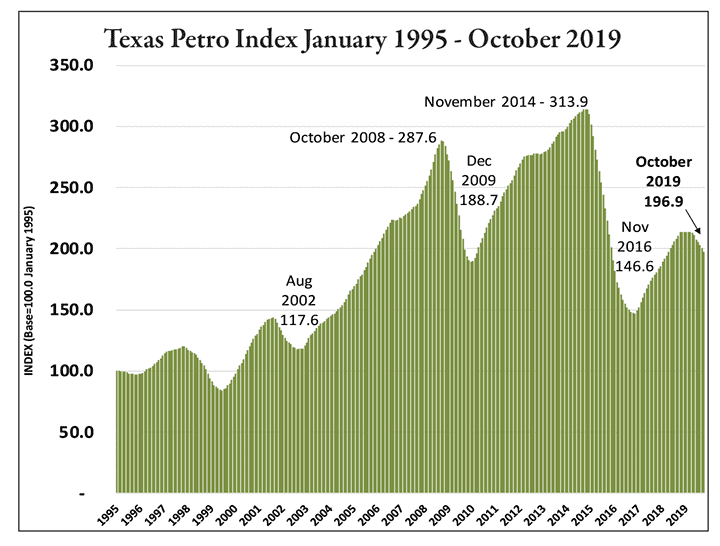The oil and natural gas industry in Texas and the United States established record levels of production in 2019 and even became a net petroleum exporter for the first time since records have been kept.
Crude oil production nationwide peaked at 12.5 barrels per day, and net petroleum exports were 89,000 barrels per day in September.
Texas led all states producing 5.3 million b/d of oil and 29.859 billion cubic feet per day of natural gas in October. Both are records. Oil production rose 9.6 percent and natural gas increased 10.6 percent in October compared to October 2018.
All of this is great news for producers and consumers. Producers are happy with the increased production volume, which generally means more revenue. Consumers are happy because the increase means more stability, and in this case, a reduction on price for petroleum products, such as gasoline and electricity.
On the other hand, the increase in supply has created an oversupply of both oil and natural gas in Texas resulting in softer prices. Oil prices have declined 25 percent from $67.19 per barrel in October 2018 to $50.25 for West Texas Intermediate posted price in October this year. Natural gas took a much bigger hit dropping 46 percent from $2.82 in October 2018 to $1.52 this October, as reported by the Texas Petro Index.
The Texas Petro Index, which compares various industry indicators, notes in its report released this week that the reduction in commodity prices has attributed to a decline in activity. The Texas Petro Index compared indicators in October 2018 to October 2019, which revealed that:
- the rig count dropped from 533 to 419 (21.4 percent),
- drilling permits slid from 1,149 to 971 (15.5 percent),
- oil well completion down from 987 to 537 (45.6 percent),
- gas well completions declined from 170 to 117 (31.2 percent),
- total oil and gas employment reduced from 226,725 to 220,500 (2.5 percent), and
- the Texas Petro Index went from 213.3 to 196.9 (8 percent.)
“Oil and gas activity in Texas is in a state of decline in 2019, though it could obviously be much worse” observed economist Karr Ingham, author of the Texas Petro Index. “Crude oil prices are down from their peak in October 2018, but rather than continue to decline, prices have stabilized in the $50-55 range, and higher at times. The fact that crude oil prices remain steady, but below their recent cyclical peaks, suggests a market that is generally well-supplied, and this is a win for household and business consumers in the US.”
Ingham said other factors are at work in terms of downward pressure on upstream oil and gas activity as well. “It is true that the providers of development capital have reigned in operators, placing a premium on positive returns on capital rather than growth,” he said.
“The natural gas issues, especially in the Permian, continue to hamper crude oil development activity to some degree as pipeline capacity, while somewhat improved, remains insufficient to move the associated gas production to the marketplace,” he said.
“But mostly, it is a 20% decline in crude oil prices that has pushed activity levels downward this year. Investor sentiment and operator attitudes would change for the better given a $20 increase in the price of crude oil,” Ingham said.
Alex Mills is the former President of the Texas Alliance of Energy Producers.
Alex Mills is the former President of the Texas Alliance of Energy Producers. The Alliance is the largest state oil and gas associations in the nation with more than 3,000 members in 305 cities and 28 states.





